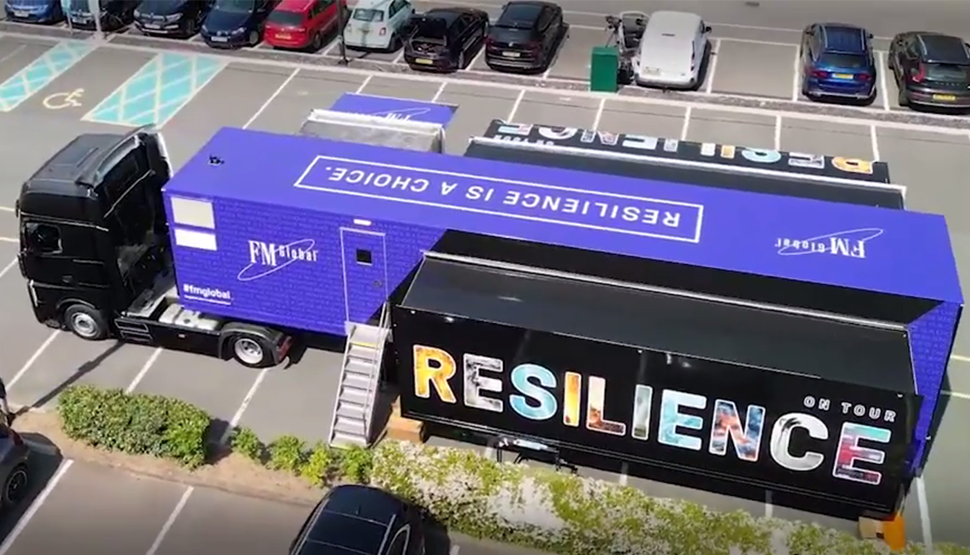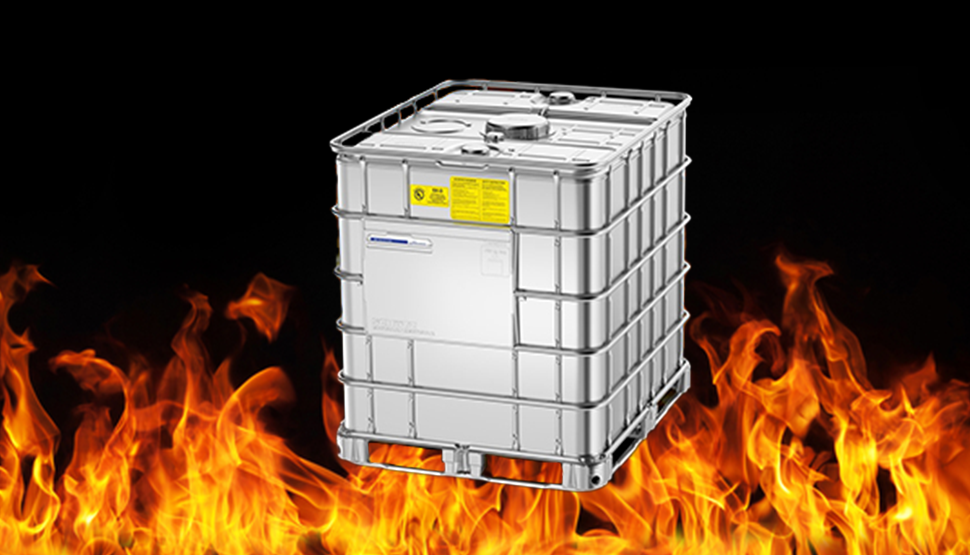FM Approved Solutions Help Mitigate Risk of Ignitable Liquids
Setting a progressive benchmark for safety, FM Approved ignitable liquid storage solutions advance property loss prevention practices

Nearly every industry uses ignitable liquids—fuels, process chemicals, hydraulic fluids, solvents, paints, coatings, adhesives, vegetable oils, waxes, and polishes. The risk for pool, spray and 3D spill fires posed by ignitable liquids is immense. In fact, FM Global values the loss potential of ignitable liquids among its clients to be upwards of USD$155 billion.
Facilities that rely on ignitable liquids must balance the need to provide sufficient protection and confinement of ignitable liquids (a term that encompasses both flammable and combustible liquids) with the need to freely access and move those liquids as required by production processes.
Fire and explosion are the two main hazards posed by ignitable liquids. When you mitigate these risks, you are not only preventing the destruction of buildings, assets, and materials, but also the disruption of business operations, the threat to brand reputation and the impact on the surrounding community and environment.
Managing the risks of ignitable liquids requires a comprehensive approach, including proper transportation and handling, and adequate active and passive fire protection. Ignitable liquid containment, in particular, presents a unique challenge because of the high heat release rate of the liquids and the fact that liquids and their vapors can flow freely past inadequate barriers (fig 1).

It’s not surprising that FM Approvals has developed more than 20 standards to help provide FM Approved solutions that can be used to mitigate the risk posed by ignitable liquids. In fact, the Approval Guide lists more than 1,500 products that are FM Approved for this purpose, including:
- Ignitable liquid doorway spill barriers
- Ignitable liquid drainage floor systems
- Hydrocarbon leak detectors
- Industrial fluids
- Intermediate bulk containers (IBCs)
- Manual drum pumps
- Safety bungs
- Safety containers
- Self-closing faucets
- Storage buildings
- Storage cabinets
- Transformer fluids
Safe storage and transport
Earlier this year, the FM Global’s 53-foot traveling “Resilience Tour” hazard mitigation lab began touring the USA and Europe (fig 2). Among the many interactive exhibits on the truck is an innovative composite intermediate bulk container (IBC), the first ever to earn the FM Approvals mark, based on the requirements of Approval Standard 6020, Composite Intermediate Bulk Containers.

The same FM Approved IBC—the ECOBULK SX-D from Schütz Packaging Systems of Germany—is also featured in FM Global’s permanent SimZone in its Singapore headquarters (fig 3).

Millions of composite IBCs—ranging in volume from 119 gal (450 L) to 793 gal (3,000 L)—are used globally for the shipping and storage of a vast range of liquids. Composite IBCs provide an economical and efficient way to store, transport and dispense a vast range of liquids.
One of the most common configurations of IBC features a cube-shaped metal cage with a blow-molded plastic inner container on a wooden or steel pallet. Unfortunately, this type of IBC is susceptible to punctures, hot work, external fires, and vapor ignition by static discharge.
“Suddenly, we jumped from 55 gallons in a steel drum to 275 gallons or more in an IBC, which is essentially a plastic container,” notes John LeBlanc, vice president and senior engineering technical specialist in FM Global’s chief engineer’s group. “Even a relatively small heat source can rupture one of these composite IBCs, resulting in a large pool fire that can overwhelm sprinkler systems.”
Approved in late 2020, the ECOBULK SX-D composite IBC from Schütz features double-wall construction with an inner plastic container surrounded by a sealed metal shell that is capable of containing the contents should the inner HDPE layer be breached. The new IBC is the same size and capacity of conventional composite IBCs, but offers protection against potentially catastrophic pool fires.
Complementary solutions
Two other solutions that can make life easier and safer for the users of intermediate bulk containers have earned the FM Approved mark in the past few years.
The Model BWCon 1.400 IBC fire protection containment unit from Minimax Viking (fig 4) earned the FM Approved mark in 2019 by satisfying the requirements of Approval Standard 6086, Storage Containers for IBCs. The system is a stainless-steel storage box designed to hold and protect a single IBC when located in manufacturing, process, and other critical areas.

The system can capture the contents of an IBC and limit the size of a potential pool fire, providing protection in areas where a fixed fire protection system is not in place or is not adequate to protect against an ignitable liquid fire. The unit has additional capacity to capture fire protection system discharge. According to the maker, the Minimax Viking IBC containment system is most commonly used by manufacturers to make it safer to use standard IBCs on the shop floor.
Safer floors
The second complementary solution was designed initially as a drainage system for spilled aircraft fuel in and around hangers; however, it also has the potential to provide greater safety when handling IBCs, indoors or out.
The ignitable liquid drainage floor system (fig 5) from Houston, Texas-based Safespill Systems LLC can automatically capture and remove any liquid spilled on its surface, including ignitable liquids. The system has been developed and refined through fire and spill testing.

The floor system earned the FM Approved mark in 2017 based on the requirements of Approval Standard 6090, Ignitable Liquid Drainage Floor Assemblies.
Safer fluids
Industrial fluids—including hydraulic fluids, lubricants, heat transfer fluids and other specialized fluids --stop our trucks, control our jet aircraft, cool transformers, form hot metal into usable shapes, and help generate and transmit electricity.
Pressurized industrial fluids--such as turbine lubrication and control oils or hydraulic fluid used to power metal forming machines—present a considerable fire hazard. High pressure piping with welded or threaded joints and metal-reinforced tubing is used to conduct industrial fluids at pressures up to 10,000 psi (69 MPa).
Fluid released under this kind of pressure typically results in an atomized spray or mist that can easily ignite when it contacts hot surfaces, open flame or an electric arc. The resulting fire is torch-like and very difficult to control, even with automatic sprinkler protection.
Industrial fluids are liquids that are vegetable oils, synthetic fluids, fluids composed of two or more components in aqueous solutions, emulsions, petroleum-based mineral oils, or other types of base stocks that are processed for stability and resilience. The use of an FM Approved industrial fluid may prevent or significantly reduce the extent of damage in a fire.
Approval Standard 6930, Fire Performance of Industrial Fluids, and Approval Standard 6933, Transformer Fluids, are two standards that are helping to provide FM Approved fire safe fluids that can limit the risk of pool, spray, and 3D spill fires. There are approximately 400 FM Approved industrial fluids listed in the Approval Guide.
Fires caused by ignitable liquids do not happen every day. But when they do, the results can often be catastrophic due to heat intensity and the potential for spread. Fortunately, a comprehensive suite of FM Approved solutions can help prevent and minimize the impacts of ignitable liquid fires.
Setting a progressive benchmark for safety, FM Approved ignitable liquid storage solutions advance property loss prevention practices with confirmation that each one functions as intended and adheres to the highest standards of quality, technical integrity, and performance.
